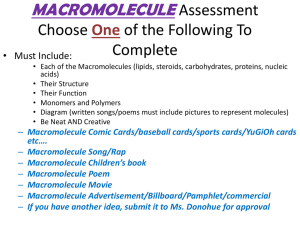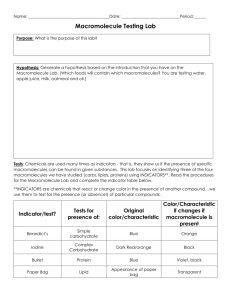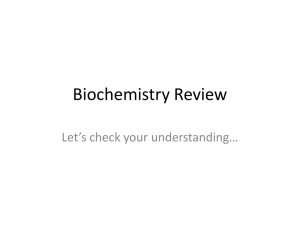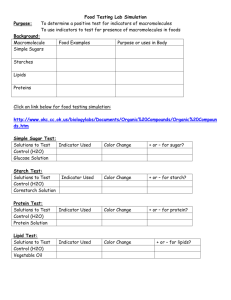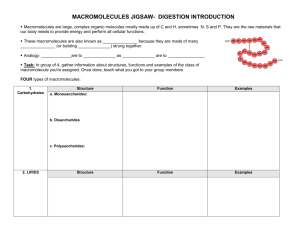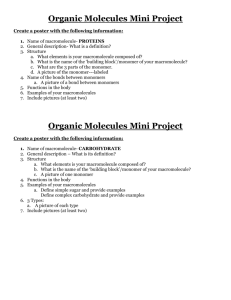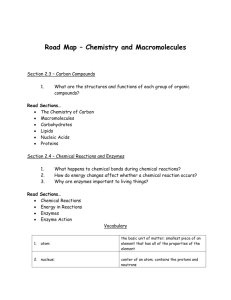PRELAB: MACROMOLECULE TESTING! Purpose: What is the
advertisement
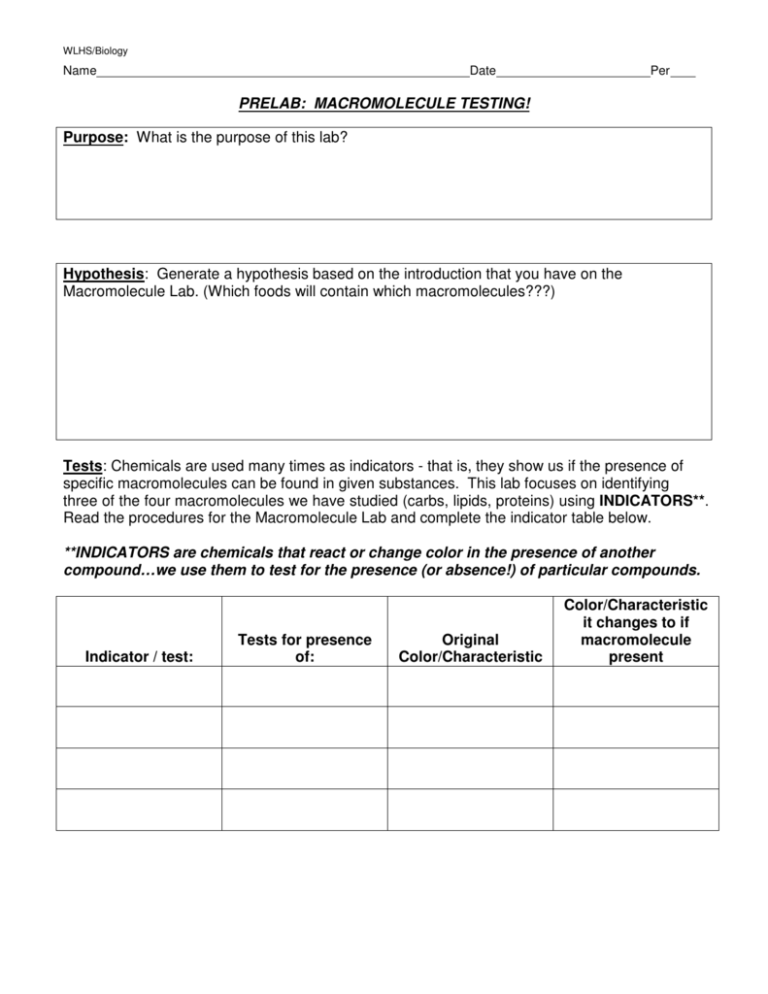
WLHS/Biology Name Date Per PRELAB: MACROMOLECULE TESTING! Purpose: What is the purpose of this lab? Hypothesis: Generate a hypothesis based on the introduction that you have on the Macromolecule Lab. (Which foods will contain which macromolecules???) Tests: Chemicals are used many times as indicators - that is, they show us if the presence of specific macromolecules can be found in given substances. This lab focuses on identifying three of the four macromolecules we have studied (carbs, lipids, proteins) using INDICATORS**. Read the procedures for the Macromolecule Lab and complete the indicator table below. **INDICATORS are chemicals that react or change color in the presence of another compound…we use them to test for the presence (or absence!) of particular compounds. Indicator / test: Tests for presence of: Original Color/Characteristic Color/Characteristic it changes to if macromolecule present WLHS/Biology LAB: Macromolecule Testing!! INTRODUCTION: One characteristic of life is that living things are made up of molecules containing carbon. These are called ORGANIC MOLECULES. In our class we have been referring to them as macromolecules since they are necessary for life. The most common organic compounds found in living organisms are LIPIDS, CARBOHYDRATES, PROTEINS, and NUCLEIC ACIDS. Common foods, which often consist of plant materials or substances derived from animals, are also combinations of these organic compounds. Simple chemical tests with substances called indicators can be conducted to determine the presence of organic compounds. A color change of an indicator is usually a positive test for the presence of an organic compound. PURPOSE: To use indicators to test for the presence of lipids, carbohydrates, and proteins in various foods. MATERIALS: Indicators (Biuret reagent, Benedict’s solution, Lugol’s solution) Food in bottles, 10 test tubes, beaker, hot plate, test tube holder, brown paper towel, 2 well plates. PROCEDURE: LIPIDS (1 test) TEST 1: Testing for Lipids: Part I 1. Tear off a piece of paper towel 30 cm long and put the names of your group members in the upper right hand corner. 2. Draw 6 small squares, approximately 3 cm each, and label each with the name of 1 of the foods (water, oil, milk, oatmeal, apple juice, and Unknown X). 3. Put 1 drop of each of the foods in the corresponding boxes on the paper towel. 4. Put the paper towel aside while you do the other 4 tests. 5. When the paper towel is dry, record your observations in the data table below. Look for a grease stain. CARBOHYDRATES (2 tests) TEST 2: Testing for Starches 1. Fill 6 wells in your well plate: water, oil, milk, oatmeal, apple juice, and Unknown X. (see diagram) 2. Add 10 drops of Iodine Solution to each well. 3. Check for any color change and record data in table. 4. Clean and dry well plate TEST 3: Testing for Sugars 1. Put 1 dropper full of each food (water, oil, milk, oatmeal, apple juice, and Unknown X) in 6 different test tubes. Make sure to LABEL all test tubes. 2. Add 10 drops of Benedict’s Solution to each test tube and place them all CAREFULLY into the hot water bath for 3-5 minutes. 3. Remove test tubes from hot water bath using designated tongs and place them into test tube holders. Note the color change and record into the table. 4. Wash all test tubes and place in test tube racks upside-down to dry. PROTEINS (1 test) TEST 4: Testing for Proteins 1. Fill 6 wells in your well plate: water, oil, milk, oatmeal, apple juice, and Unknown X. (see diagram) 2. Add 10 drops of Biuret’s Solution to each well. 3. Check for any color change and record data in table. 4. Clean and dry well plate ***********CLEAN UP STATION AND HAVE TEACHER INITIAL THIS LINE FOR CREDIT _________************** WLHS/Biology Diagram: 6 wells filled with the various substances. Water Oil Milk Oatmeal Apple Juice Unknown X Table 1: Results from the testing of 4 solutions for organic compounds (carbohydrates, lipids, and proteins). Lipid Tests (1 test) Substance Spot or No spot Lipid present (+) Carbohydrate Tests (2 tests) Benedict Color Sugar present (+) Lugol Color Protein Test (1) Starch present (+) Water Oil Milk Oatmeal Apple Juice Unknown X Results: 1) Which test substances contained LIPIDS? 2) Which test substances contained STARCH? 3) Which test substances contained SUGAR? 4) Which test substances contained PROTEIN? 5) Which test substances did not test positive for ANY organic compounds? Biuret Color Protein present (+) WLHS/Biology POST LAB QUESTIONS – Macromolecules Testing 1) Which macromolecules (or types of macromolecules) did you test for in this lab? 2) What were the test substances (reagents) you used to the tests? 3) What food substances did you test? 4) Lipid “Spot” Test: a) What is the name of the test substance and what does it test for? b) How do you know from the test that this macromolecule is present? c) What were the results of the test? d) What can you conclude from the results about the presence or absence of this macromolecule in each substance tested? 5) Carbohydrate Benedict” Test: a) What is the name of the test substance and what does it test for? b) How do you know from the test that this macromolecule is present? c) What were the results of the test? d) What can you conclude from the results about the presence or absence of this macromolecule in each substance tested? 6) Carbohydrate Lugol’s Test: a) What is the name of the test substance and what does it test for? b) How do you know from the test that this macromolecule is present? c) What were the results of the test WLHS/Biology d) What can you conclude from the results about the presence or absence of this macromolecule in each substance tested? 7) Protein Biurets Test: a) What is the name of the test substance and what does it test for? b) How do you know from the test that this macromolecule is present? c) What were the results of the test? d) What can you conclude from the results about the presence or absence of this macromolecule in each substance tested? 8) Summarize all of the positive test results 9) Describe anything that might have affected your results (sources of error). 10) Make a suggestion for improving the lab in the future.
